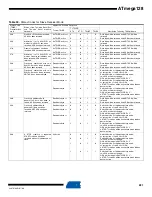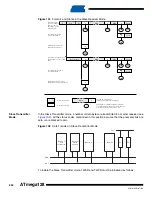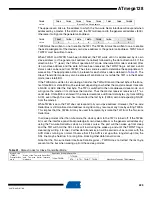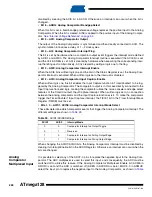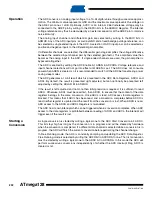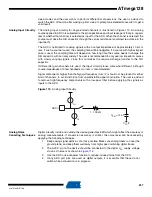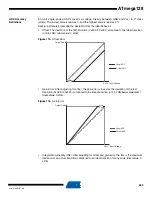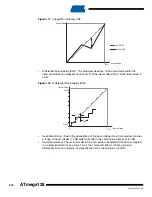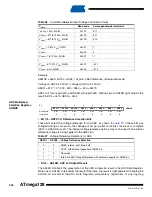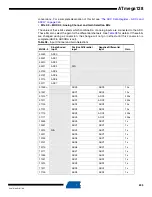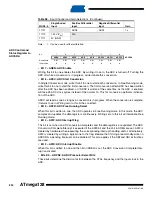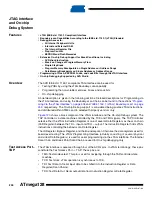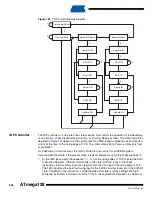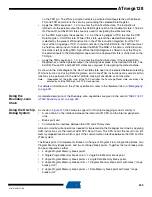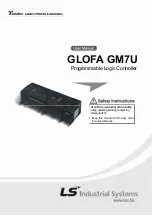
235
2467S–AVR–07/09
ATmega128
Differential Gain
Channels
When using differential gain channels, certain aspects of the conversion need to be taken into
consideration.
Differential conversions are synchronized to the internal clock CK
ADC2
equal to half the ADC
clock. This synchronization is done automatically by the ADC interface in such a way that the
sample-and-hold occurs at a specific edge of CK
ADC2
. A conversion initiated by the user (i.e., all
single conversions, and the first free running conversion) when CK
ADC2
is low will take the same
amount of time as a single ended conversion (13 ADC clock cycles from the next prescaled
clock cycle). A conversion initiated by the user when CK
ADC2
is high will take 14 ADC clock
cycles due to the synchronization mechanism. In free running mode, a new conversion is initi-
ated immediately after the previous conversion completes, and since CK
ADC2
is high at this time,
all automatically started (i.e., all but the first) free running conversions will take 14 ADC clock
cycles.
The gain stage is optimized for a bandwidth of 4 kHz at all gain settings. Higher frequencies may
be subjected to non-linear amplification. An external low-pass filter should be used if the input
signal contains higher frequency components than the gain stage bandwidth. Note that the ADC
clock frequency is independent of the gain stage bandwidth limitation. E.g. the ADC clock period
may be 6 µs, allowing a channel to be sampled at 12 kSPS, regardless of the bandwidth of this
channel.
Changing Channel
or Reference
Selection
The MUXn and REFS1:0 bits in the ADMUX Register are single buffered through a temporary
register to which the CPU has random access. This ensures that the channels and reference
selection only takes place at a safe point during the conversion. The channel and reference
selection is continuously updated until a conversion is started. Once the conversion starts, the
channel and reference selection is locked to ensure a sufficient sampling time for the ADC. Con-
tinuous updating resumes in the last ADC clock cycle before the conversion completes (ADIF in
ADCSRA is set). Note that the conversion starts on the following rising ADC clock edge after
ADSC is written. The user is thus advised not to write new channel or reference selection values
to ADMUX until one ADC clock cycle after ADSC is written.
Special care should be taken when changing differential channels. Once a differential channel
has been selected, the gain stage may take as much as 125 µs to stabilize to the new value.
Thus conversions should not be started within the first 125 µs after selecting a new differential
channel. Alternatively, conversion results obtained within this period should be discarded.
The same settling time should be observed for the first differential conversion after changing
ADC reference (by changing the REFS1:0 bits in ADMUX).
If the JTAG Interface is enabled, the function of ADC channels on PORTF7:4 is overridden.
Refer to
Table 42, “Port F Pins Alternate Functions,” on page 83
.
Table 95.
ADC Conversion Time
Condition
Sample & Hold (Cycles from
Start of Conversion)
Conversion Time
(Cycles)
First conversion
13.5
25
Normal conversions, single ended
1.5
13
Normal conversions, differential
1.5/2.5
13/14

